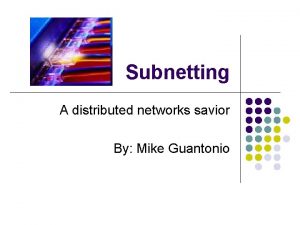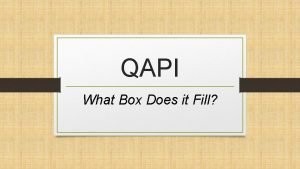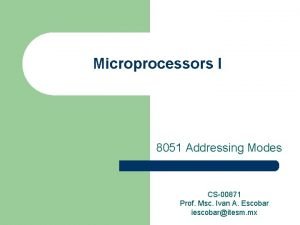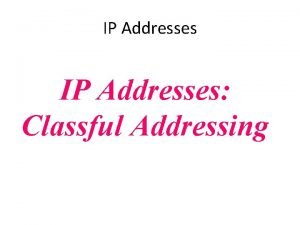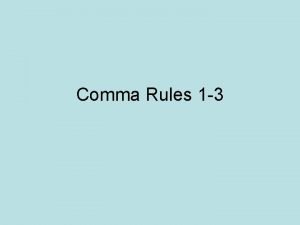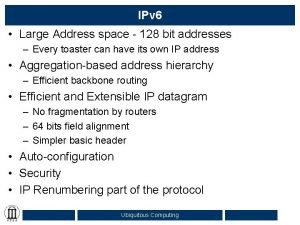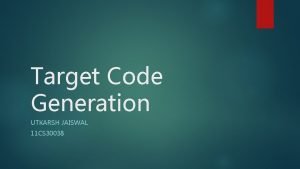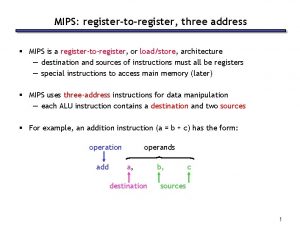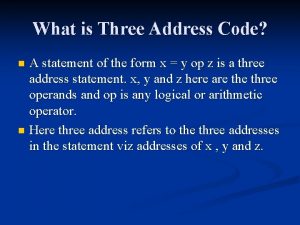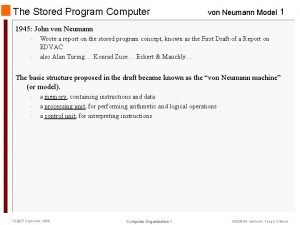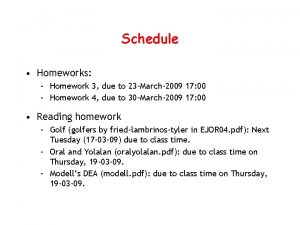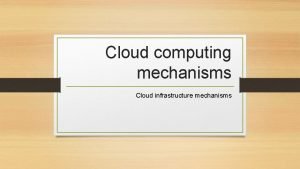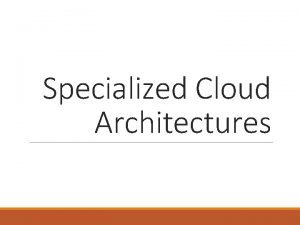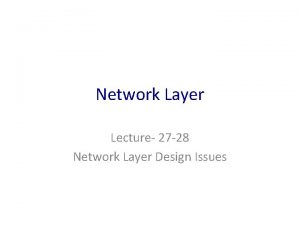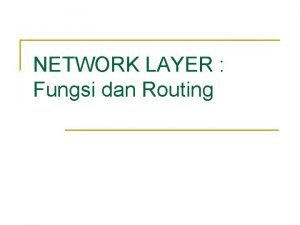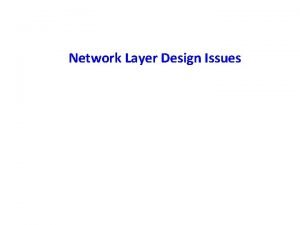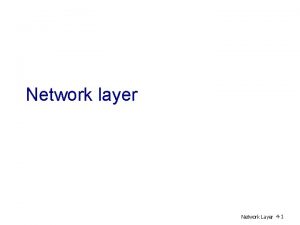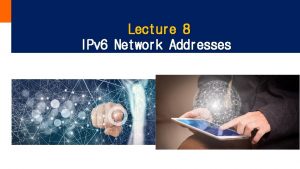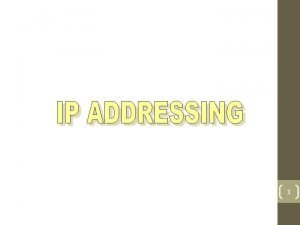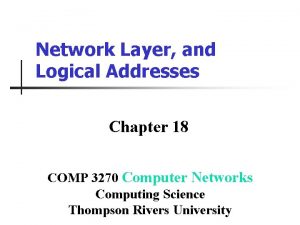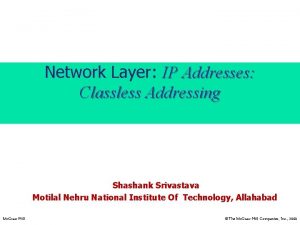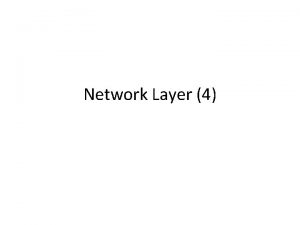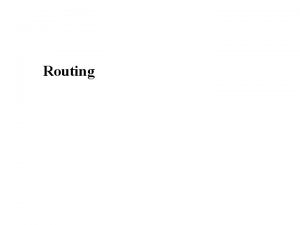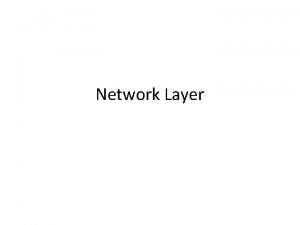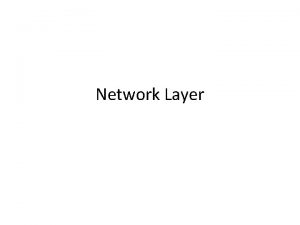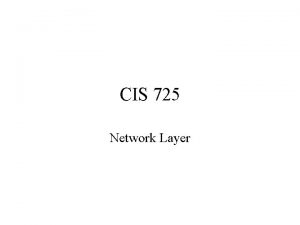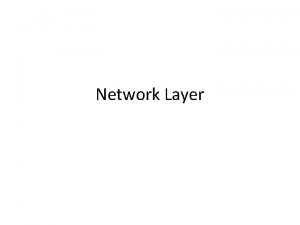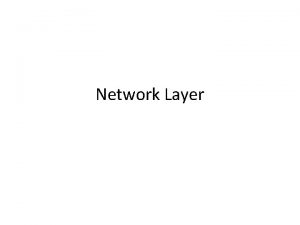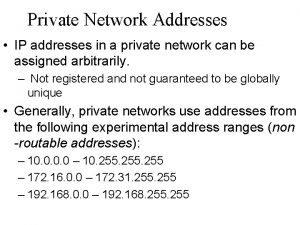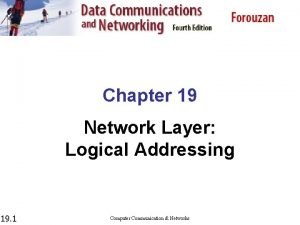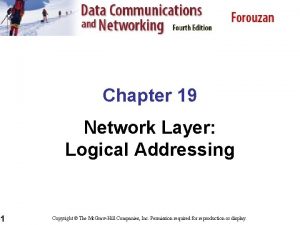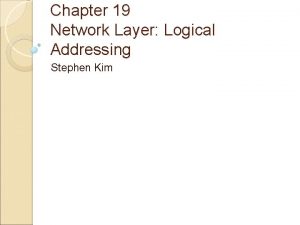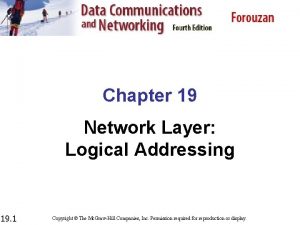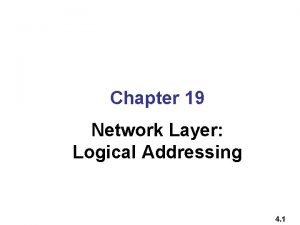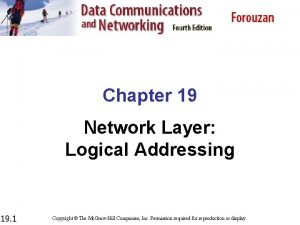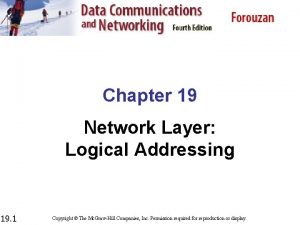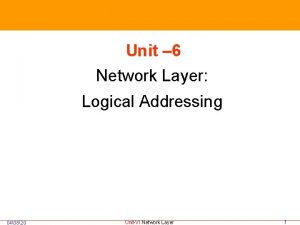Network Layer Logical Addressing IPv 4 ADDRESSES An




































- Slides: 36

Network Layer: Logical Addressing

IPv 4 ADDRESSES An IPv 4 address is a 32 -bit address that uniquely and universally defines the connection of a device (for example, a computer or a router) to the Internet.

Dotted-decimal notation and binary notation for an IPv 4 address

Example Find the error, if any, in the following IPv 4 addresses.

In classful addressing, the address space is divided into five classes: A, B, C, D, and E.

Finding the classes in binary and dotted-decimal notation

Table 1 Number of blocks and block size in classful IPv 4 addressing

Table 2 Default masks for classful addressing

Classful addressing, which is almost obsolete, is replaced with classless addressing.

A block of 16 addresses granted to a small organization

A network configuration for the block 205. 16. 37. 32/28

The first address in a block is normally not assigned to any device; it is used as the network address that represents the organization to the rest of the world.

Each address in the block can be considered as a two-level hierarchical structure: the leftmost n bits (prefix) define the network; the rightmost 32 − n bits define the host.

Host and Net division n n n 19. 14 Mask Address: 11001101 00010000 00100101 00100111 Mask: 11111111 11110000 Net id 11001101 00010000 00100101 00100000 Classless Interdomain Routing (CIDR) Subnetting Supernetting

Test your Understanding n n 19. 15 A block of addresses is granted to a small organization. We know that one of the addresses is 205. 16. 37. 39/28. What is the first address in the block? Also Find the last address in the block.

small business that needs 16 addresses 205. 16. 37. x 19. 16

An organization is given the block 17. 12. 14. 0/26, which contains 64 addresses. The organization has three offices and needs to divide the addresses into three subblocks of 32, 16, and 16 addresses. We can find the new masks by using the following arguments: n n 19. 17 Suppose the mask for the must be 32, which means Suppose the mask for the must be 16, which means first subnet is n 1, then 232 - n 1 that n 1 =27. second subnet is n 2, then 232 - n 2 that n 2 = 28. third subnet is n 3, then 232 - n 3 that n 3 =28. This means that we have the masks 27, 28 with the organization mask being 26.

Configuration and addresses in a subnetted network

Three-level hierarchy in an IPv 4 address

Table 3 Addresses for private networks

A NAT implementation

Addresses in a NAT

NAT address translation

Table 4 Five-column translation table

IPv 6 ADDRESSES Despite all short-term solutions, address depletion is still a long-term problem for the Internet. This and other problems in the IP protocol itself have been the motivation for IPv 6.

An IPv 6 address is 128 bits long.

IPv 6 address in binary and hexadecimal colon notation

Abbreviated IPv 6 addresses

Prefixes for provider-based unicast address

Multicast address in IPv 6

Reserved addresses in IPv 6

Local addresses in IPv 6

Three transition strategies

Three transition strategies

Tunneling

Header translation
 Flat addressing vs hierarchical addressing
Flat addressing vs hierarchical addressing What is logical equivalence
What is logical equivalence Logical form and logical equivalence
Logical form and logical equivalence 방송통신대학교
방송통신대학교 Pigmented layer and neural layer
Pigmented layer and neural layer How are glands classified
How are glands classified Secure socket layer and transport layer security
Secure socket layer and transport layer security Presentation layer functions
Presentation layer functions Secure socket layer and transport layer security
Secure socket layer and transport layer security Secure socket layer and transport layer security
Secure socket layer and transport layer security Secure socket layer and transport layer security
Secure socket layer and transport layer security Layer 2 e layer 3
Layer 2 e layer 3 Layer-by-layer assembly
Layer-by-layer assembly Layer 2 vs layer 3 bitstream
Layer 2 vs layer 3 bitstream Are we running out of ip addresses
Are we running out of ip addresses Qapi at a glance
Qapi at a glance Parts of a letter
Parts of a letter I8051
I8051 Find the class of the following classful ip addresses
Find the class of the following classful ip addresses As well as comma
As well as comma Reserved addresses
Reserved addresses 128 bit addresses
128 bit addresses Ap style basics
Ap style basics Utkarsh jaiswal
Utkarsh jaiswal Mips instruction format
Mips instruction format Three address statement
Three address statement Memory locations and addresses in computer organization
Memory locations and addresses in computer organization (acv-s03) homework - addresses and references
(acv-s03) homework - addresses and references Polling agent in cloud computing
Polling agent in cloud computing Persistent virtual network configuration architecture
Persistent virtual network configuration architecture Network layer design
Network layer design Design issues of network layer
Design issues of network layer Fungsi network layer adalah …
Fungsi network layer adalah … Network layer design issues
Network layer design issues Introduction to network layer
Introduction to network layer 5 layer network model
5 layer network model Two layer network
Two layer network














